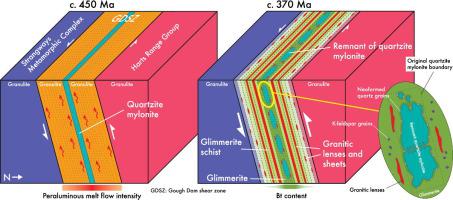Gondwana Research ( IF 7.2 ) Pub Date : 2021-09-15 , DOI: 10.1016/j.gr.2021.09.005 D. Silva 1 , N.R. Daczko 1 , S. Piazolo 1, 2 , T. Raimondo 3, 4

|
The paradigm for hydrous high-strain zones that cut dry host rocks is for fluid-rock interaction to have involved aqueous fluids. However, the role of silicate melt is increasingly recognised. This contribution examines the formation of glimmerite (biotitite) bands during melt migration in the Gough Dam shear zone, a high-strain zone in central Australia that was active during the Alice Springs Orogeny (c. 450–300 Ma). The glimmerite bands cut and replace a range of quartzo-feldspathic protoliths, including granitic gneiss and quartzite. Melt that migrated through the high-strain zone is interpreted to have penetrated relict layers along a network of fractures, enhancing dissolution of the precursor rock and causing replacement by glimmerite crystallisation. Microstructures indicative of the former presence of melt in the high-strain zone include: pseudomorphs of former melt pockets of granitic composition; small dihedral angles of interstitial phases; elongate grain boundary melt pseudomorphs; neighbourhoods of grains connected in three dimensions; and localised static grain growth and recovery. Other microstructures indicative of melt-present deformation include randomly oriented neosome grains, and evidence of activation of multiple slip systems during deformation. The degree of quartzite modification to glimmerite is recorded by an increase in biotite mode, and correlated with higher Ti concentrations in biotite (higher apparent temperature) and changes to trace element and REE compositions. Melt-assisted coupled dissolution-precipitation reactions during melt flux are interpreted to partially reset Proterozoic monazite U-Pb ages inherited from the protolith (> 1630 Ma) to younger Palaeozoic ages, with a complex age pattern partially congruent with the Alice Springs Orogeny (apparent ages range from c. 606–371 Ma, with a dominant age peak at c. 451 Ma). We propose that the glimmerite formed during dynamic melt migration of an externally-derived hydrous peraluminous melt, driving reaction replacement of various felsic protoliths during this orogenic event.
中文翻译:

闪锌矿:地壳尺度高应变带内熔岩相互作用的产物
切割干燥主岩的含水高应变区的范例是流体-岩石相互作用涉及含水流体。然而,越来越多地认识到硅酸盐熔体的作用。这一贡献研究了高夫坝剪切带熔体迁移过程中闪锌矿(黑云母)带的形成,高夫坝剪切带是澳大利亚中部的一个高应变带,在爱丽斯泉造山运动期间活跃(c. 450–300 毫安)。闪光带切割并取代了一系列石英长石原岩,包括花岗片麻岩和石英岩。迁移通过高应变区的熔体被解释为沿着裂缝网络渗透了残余层,增强了前体岩石的溶解并导致了闪锌矿结晶的替代。表明高应变区先前存在熔体的微观结构包括:间隙相的小二面角;细长的晶界熔体假晶;在三个维度上连接的谷物邻域;和局部静态晶粒生长和恢复。指示熔体存在变形的其他微观结构包括随机取向的新粒、以及变形过程中多重滑移系统激活的证据。石英岩改质为闪锌矿的程度通过黑云母模式的增加来记录,并与黑云母中更高的 Ti 浓度(更高的表观温度)以及微量元素和 REE 成分的变化相关。熔体通量期间的熔体辅助溶解-沉淀耦合反应被解释为部分重置从原岩继承的元古代独居石 U-Pb 年龄 (> 1630马)年轻古生代年龄,与和艾丽斯普林斯造山运动部分全等复杂年龄图案(表观年龄范围从Ç。606-371马,与主导年龄峰Ç。451 MA)。我们提出,在外部衍生的含水过铝熔体的动态熔体迁移过程中形成了闪锌矿,在该造山事件期间驱动了各种长英质原岩的反应置换。





















































 京公网安备 11010802027423号
京公网安备 11010802027423号